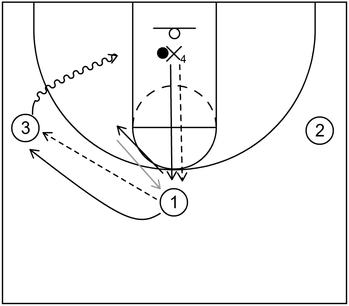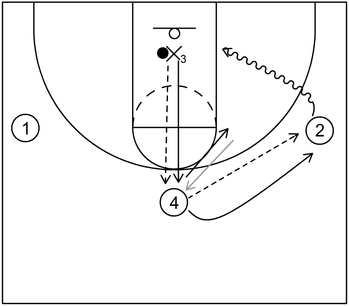What does jump to the ball mean in basketball
Jump to the ball is a basketball defensive action that occurs when a defender, as the name implies, jumps to the direction of the basketball when an offensive player passes it from one perimeter area of the court to the next adjacent perimeter area.
As a brief example, if the ball gets passed from the top to the wing, the on-ball defender that was initially guarding the top will then jump to the ball, typically into the gap of the high post elbow between the top and the wing.
What is the general technique of jumping to the ball
Generally speaking, the defender will quite literally execute a side jump as the technique when jumping to the ball. The side jump is essential as opposed to a typical defensive slide because it allows the defender to move from one area to the next in a much quicker fashion.
Also, the defender that jumps to the ball should maintain vision of both the offensive player that executed the pass as well as the offensive player that receives the ball.
To accomplish this, the defender could jump to the ball and then use their pointer fingers on both hands to point to both the offensive player with the ball and the offensive player that they are currently guarding.
In essence, the defender should not jump to the ball with their back exclusively towards the offensive player that executed the pass.
If that were to occur, then the player that executed the initial pass could easily backdoor cut to the basket and receive the ball once again for a possible scoring opportunity.
Which defensive systems or tactics could use the jump to the ball concept
Jump to the ball is mainly used within the man to man defensive system and more specifically, it is a important component of the help defense tactic.
The primary objective of help defense is for off-ball defenders to provide support for an on-ball defender. However, the method of help that is given generally depends on how far away those same off-ball defenders are from the ball.
In this case, when the ball gets passed from one area to the next adjacent area, the initial on-ball defender is now an adjacent off-ball help defender.
When that occurs, the adjacent help defender should immediately jump to the ball to prevent or limit certain actions by the offensive team.
Which offensive actions could be prevented or limited by jumping to the ball
Jumping to the ball could prevent potential face cuts by the player that executed the pass and at the same time, it can limit immediate offensive dribble penetration by the player that receives the ball from the initial pass.
Prevent potential face cut
First, upon jumping to the ball, the off-ball help defender takes away the potential face cut by the offensive player that made the initial pass to the adjacent teammate.
In other words, if the offensive player that executed the initial pass decides to cut to the basket, that same player will have to cut behind the defender that jumped to the ball as opposed to in front.
When that occurs, the offensive player that received the ball will have to throw it over the outstretched arms of the helping defender that jumped to the ball, if the cutting player was to receive it.
However, throwing this type of pass increases the chances of a potential turnover which is harmful to the offensive team but favorable to the defensive team.
Limit offensive dribble penetration
Second, after jumping to the ball, the off-ball help defender immediately fills the gap space that is between the offensive player that executed the initial pass and the offensive player that received that same pass.
What this essentially means is that the offensive player that received the ball will have only a limited opportunity to create adequate dribble penetration near that same gap space because the help defender is standing in that area.
In other words, if the offensive player that received the ball desires to attack the rim, that same player can only go in the other direction, at least during that particular moment.
What is an example of a simple jump to the ball basketball drill
Part 1

This is an example of a simple jump to the ball basketball drill. The general setup of the drill starts with offensive players 1, 2, and 3 that are lined up near the top, the left side wing, and the right side wing.
In addition to that, there is a defensive player denoted as X4 positioned in the lane in front of the basket.
Furthermore, it is possible to use more defenders who could start under the basket near the baseline. However, to keep things simple, only one defender is shown on the diagram.
It should also be noted that the numbers do not represent the standard basketball positions and are mainly used for demonstrative purposes.
So, players 1, 2, 3 or X4 do not have to play the positions of point guard, shooting guard, small forward, or power forward, respectively.
To begin the drill, X4 will pass the ball to 1 at the top and immediately sprint to the ball and execute a defensive closeout.
Next, 3 receives the ball from 1 and on the air time of that pass, X4 jumps to the ball into the gap between the left side high post elbow and the top.
Following that, 3 dribbles towards the basket on the baseline side and scores with a layup at the basket.
After 3 makes the layup, 1 will fill the left side wing while X4 fills the top, represented by the gray arrow. Moreover, 3 will get the ball out of the net following the layup and stay near the basket.
However, if are more defenders near the baseline, then 3 would go to the end of that particular line and another defender would step in front of the basket.
Also, as a side note, by jumping to the ball in this manner, primarily in a game-like situation, this effectively means that the player on the receiving end of the pass (in this case, near the left side wing) cannot create dribble penetration towards the middle.
In other words, if the offensive player wants to gain dribble penetration, they will be influenced to stay on one side of the floor which limits the offensive team’s overall scoring options.
Part 2

This is the jump to the ball drill once again but this time, it is executed on the opposite side of the floor. In addition, 3 is now the new defender near the basket and is so denoted by X3.
To begin, X3 passes the ball to 4 at the top and immediately sprints to execute a defensive closeout.
From there, 2 receives the ball from 4 and this triggers X3 to quickly jump to the ball near the gap between right side high post elbow and the top.
Afterwards, 2 dribbles towards the basket on the baseline side and scores with a layup.
Following that, 4 fills the vacated right side wing area while X3 fills the top, represented by the gray arrow. Furthermore, 2 would become the new defender, X2 or move to the back of the line in a situation with multiple defenders.
Related: The Jump To The Ball Drill – YouTube